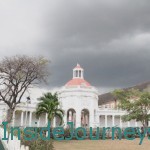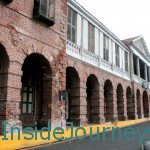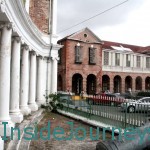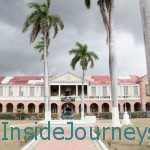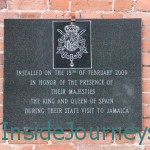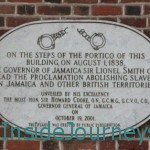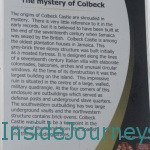I heard about jackass corn when I was younger but I don’t remember seeing let alone trying it. Lacking any context, I imagined it was a variety of corn – one that jackasses liked to eat. I know that’s pretty literal but what else could I think?
I hadn’t thought of or heard about jackass corn until sometime last year when my friend, Sandra, and I walked into 14 Parish Restaurant, a small take out spot in Hackensack, NJ. The typical assortment of sweets – rock buns, gizzadas, grater cakes – sat on display in a glass case on the counter but there was one item I didn’t recognize. Curious, I asked what it was.

I chided the young cashier for not knowing and he went back to the kitchen to ask.
“It’s jackass corn,” he said when he returned, his face still wearing a puzzled look.
Jackass (or donkey) corn is a hard biscuit made of flour, water, coconut milk, and nutmeg. It is rolled flat, cut into rectangles and baked. According to the Dictionary of Jamaican English, it’s called jackass corn because when you eat it, it sounds like the sound a donkey makes when it’s eating corn.
- 1 cup all-purpose flour
- 1/4 teaspoon baking powder
- 1 cup sugar
- 1/2 teaspoon ground nutmeg
- 1/4 teaspoon salt
- 1 cup shredded unsweetened coconut
- 3 tablespoons water
- Preheat the oven to 375F. In a medium-size bowl, combine the flour, baking soda, sugar, nutmeg and salt. Stir in the coconut. Add the water and mix, forming a very stiff dough that will not crumble.
- Roll out the dough on a floured board to 1/8-inch thickness. Cut the dough into small rectangles. Place the pieces onto a greased cookie sheet and prick each one with a fork. Bake for 8 to 9 minutes, or until brown. Remove from the oven and transfer to a plate to cool.
Jackass corn used to be a popular snack enjoyed by school children as well as adults. It fell out of favor perhaps because it’s likely seen as irrelevant, or unsophisticated next to prepared snacks like potato chips and Cheese Trix.
But one of the unforeseen and unintended impacts of migration is that Jamaicans, like other immigrant communities, cling to the traditions that keep them connected to home. One of the many food items they hold on to is jackass corn, which explains why it would be available for sale in a small restaurant in New Jersey.
As I expected, the owner said he sells mostly to people of a certain age. Since I’d never tried them, I handed over $2 for two biscuits which came wrapped tightly in plastic. My aunt couldn’t believe it when I told her what I had found.
I couldn’t bring myself to eat my treat right away and kept the jackass corn for almost a week before finally ripping off the plastic. I tried the first one. It was slightly sweet, with a hint of nutmeg, crisp but not as hard as I expected. I made a cup of tea, fresh mint, and had the second one. You can also have jackass corn on its own as a snack.
How to join the #FoodieTuesday linkup –
- Add the link to your foodie post in the link tool at the bottom of this post
- Leave a comment.
- As a courtesy, please include a link back to this post.
- Tweet, G+, Like, etc., using the hashtag #FoodieTuesday
For more recipes, check out Lucinda Scala Quinn’s cookbook, Lucinda’s Authentic Jamaican Kitchen
[simpleazon-image align=”none” asin=”0471749354″ locale=”us” height=”110″ src=”http://ecx.images-amazon.com/images/I/51vTukacb2L._SL110_.jpg” width=”98″]
 Loading InLinkz ...
Loading InLinkz ...


















